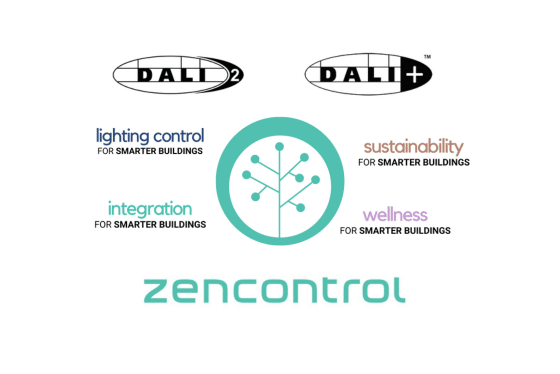When considering Building Control Systems, you will likely be considering a DALI system.
DALI (Digital Addressable Lighting Interface) is a widely used protocol for lighting control in commercial buildings and in 2020 was adopted as the lighting control standard for Australia and New Zealand (AS/NZS62386).
In the blog below we run through the benefits of using either (or both) a wired DALI-2 or wireless DALI+ system.
Further we look at the even greater capabilities of a DALI system when zencontrol’s advanced software and other technologies are included.

If you are considering a building control system, let’s explore the benefits of using DALI-2 (wired) or DALI+ (wireless):
- Individual Addressability:
- Unlike earlier lighting systems (such as 1-10V or DSI), DALI allows each device (such as LED drivers, sensors, and emergency drivers) to be individually addressed.
- This flexibility enables precise control over individual lights or dynamic grouping of circuits, enhancing customization and adaptability.
- Reduced Installation Costs:
- DALI systems require simpler and less expensive wiring compared to other systems.
- While 2-core cabling is still necessary, there’s no need for a separate bus cable.
- The system can be reprogrammed to meet future needs without changing the wiring.
- Advanced Dimming:
- DALI provides accurate, repeatable, and standardized light-output control.
- Certified DALI-2 control gear follows a standardized dimming curve designed to match human-eye sensitivity and brightness perception.
- Consistent dimming levels are achieved across fixtures and manufacturers.
- Daylight Sensing:
- DALI-2 sensors and other input devices provide information to the system.
- Occupancy and light-level sensing enable energy-efficient control based on occupancy and available natural light.
- Tunable white (Tc) control allows adjusting color temperature according to time of day and individual preference.
- Emergency Lighting Integration:
- DALI is widely used globally for robust and reliable emergency lighting solutions.
- It ensures illumination during mains supply failures.
- DALI enables automated self-testing (function test and duration test) as mandated by regulations.
- Colour Control:
- DALI-2 certification includes color control options:
- Tunable white (Tc): Allows control of correlated color temperature (CCT) from warm white to cool white.
- RGBWAF: Simple control of up to 6 color channels (Red, Green, Blue, White, Amber, and Free-colour).
- xy coordinate: Precise and repeatable selection of color coordinates from the CIE color space.
- Interoperability and Future-Proofing:
- DALI is positioned for the Internet of Things (IoT).
- New specifications enable DALI connectivity via wireless networks and IP-based networks.
- Reprogramming without hard-wiring changes ensures adaptability to future requirements.
As above, you can see how DALI-2 and/or DALI+ building control systems offer enhanced control, energy savings, and flexibility for lighting systems in commercial buildings. Designers benefit from interoperability and compliance with energy codes.
If we then consider how a zencontrol DALI-2 or DALI+ system further enhances DALI capabilities (as outlined below) it is easy to understand why our company prefer to offer this solution.
zencontrol’s features improve the DALI experience in the following ways:
1. Two-Way Feedback from Field Devices:
- Zencontrol’s software provides real-time communication between the central control system and individual DALI devices (such as luminaires, sensors, and switches).
- When a command is sent to a device (e.g., adjusting brightness or changing colour temperature), the system receives confirmation that the action was executed successfully.
- This two-way feedback ensures reliable operationand allows for proactive maintenance.
2. Intuitive User Interfaces:
- zencontrol’s user interfaces are designed with usabilityin mind.
- Building managers, facility operators, and end-users can easily navigate the system.
- Features include:
- Graphical floor plans: Visual representation of the building layout with device status indicators.
- Scene control: Predefined lighting scenes for different scenarios (e.g., presentation mode, energy-saving mode).
- Scheduling: Timed events for automatic lighting adjustments.
- Energy monitoring: Real-time data on energy consumption.
- Fault detection: Alerts for malfunctioning devices.
- Intuitive interfaces empower users to make informed decisions and optimize lighting control.
3. Energy Efficiency and Cost Savings:
- Zencontrol’s software allows for fine-tuningof lighting levels based on occupancy, daylight availability, and user preferences.
- Dynamic adjustments reduce energy consumption and extend the lifespan of lamps and luminaires.
- Energy reports help identify areas for further optimization.
- Overall, this contributes to sustainable building management.
4. Scalability and Flexibility:
- zencontrol’s solution is scalable from small offices to large commercial complexes.
- It supports multi-site management, making it suitable for organisations with multiple locations.
- The software adapts to changes in building layout, tenant requirements, and future expansions.
5. Integration:
- As it is built on the open DALI protocol zencontrol integrates seamlessly with all other DALI-certified products regardless of the manufacturer.
- Zencontrol interfaces with MQTT allowing efficient communication with building management systems.
- Zencontrol works with stage lighting through DMX, supporting up to 192 channels of DMX control, simultaneous dimming, and allows the use of DALI switches and sensors.
- BACnet integration allows seamless communication between the lighting control and other building automation systems.
- Robust options for integrating security systems including volt-free outputs/inputs, Smart-io, and io-8 connections. Zencontrol’s DALI sensors and switches can even trigger security alarts for a fully integrated and secure building solution.
6. Much more than lighting control:
- zencontrol’s advanced technology allows them to offer environmental sensors that detect on air quality, sound, temperature, and much more.
- zencontrol supports integration with audio-visual systems, HVAC and third-party analytics.
- Their commitment to open standards ensures compatibility and flexibility for all options for building management.


